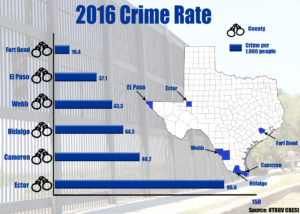A study from the UTRGV Center for Border Economic Studies has found that although the region has been depicted as dangerous by the national news media due to an influx of immigrants, crime has declined over the last 18 years.
The report, “Where have the criminals gone? Negative crime growth in South Texas,” was written by UTRGV economics and finance Associate Professor Salvador Contreras and was published this summer.
It includes aggregated data from the FBI Uniform Crime Reporting Program from 1999 to 2016 and crime arrest rates per 1,000 people.
“The border region has been portrayed by the national media as unsafe,” the report introduction reads. “This has been in part attributed to immigrants who are depicted as criminals who bring their criminal ways to the border.”
In an interview with The Rider on Aug. 14, Contreras said one of the objectives of the report is to “show whether there is some truth to that.”
From 1999 to 2016, the study found that 187 of 249 Texas counties experienced declines in crime.
“We don’t look at what causes level of crime, so that will be its own set of research,” Contreras said. “We just wanted to know, on average, do they appear to be any differences across counties in Texas.”
Thirty large Texas counties saw a decline in average annual crime growth, including Cameron, 2.5%; El Paso, 2.5%; Webb, 1.5%; and Hidalgo, 2.3%.
The report also notes a decline in youth and adult annual crime growth among Cameron, Hidalgo, El Paso and Webb counties. Youths are categorized within 15 to 19 years of age and adults, 20 years or older.
Cameron County recorded a 3.3% decline in youth crime and 1.9% decline in adult crime; El Paso County, a 4.4% decrease in rate for youth and 1.3% decline for adult; Hidalgo County, a reduction of 2% in the rate for youth and 2.3% for adult; and Webb County, a drop of 1.1% for youth and 1.6% in adult.
“The U.S. has seen negative crime growth for the last couple of decades,” Contreras said. “So, South Texas is no different and I think that’s one of the things that we try to say in this report is that South Texas has seen a declining crime growth.”
The report also states four broad categories of crime and its average annual growth. Violent crimes include murder, manslaughter, robbery and aggravated assault; property crimes include burglary, theft and arson; Petty delinquency includes vandalism, disorderly conduct and loitering violations; and drug crimes include sale, manufacturing and possession.
“El Paso saw the largest decline in violent crime and petty delinquency,” the report states. “Webb County saw [a] small increase in all four categories. … The largest gains [in drug crime] being in Hidalgo County at 2.9%.”
Contreras said the United States has suffered an opioid epidemic and has seen large numbers of deaths in result of it.
“Across the United States, drug arrests are up, consistent to the story that there’s this bigger problem of addiction to these opioids,” he said. “What we see here in Texas is that most of Texas has also seen an increase in drug-related arrests and the border region has been no exception.”

The border region is “quite average” in the crime rate, according to the report that uses 2016 data.
“Among border counties, El Paso has the lowest rate at 37 and Cameron the largest at 46 crimes per 1,000 people,” the report states. “However, it is safe to say that the Border itself does not appear to attract more or less crime than other parts of Texas.”
Asked what the campus community members can learn from the report, Contreras replied, “The area in which they go to school at, the environment in which we live in, is just as safe as any other part of Texas, or at least the average Texas county,” he said.
For the full and complete report, visit https://faculty.utrgv.edu/salvador.contreras/images/19i2/cbest_bbb_q3i2.pdf.
Para la versión en español de este artículo, oprima aquí.






